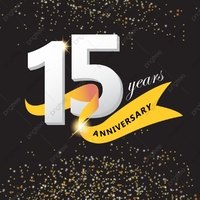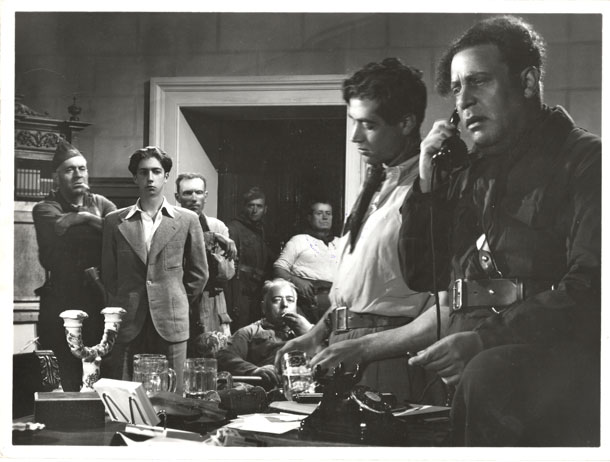Genina‘s Alcazar Spanish Civil War Film (1940)
The old city of Toledo, 40 miles south of Madrid, was captured by Republican forces on July 23rd, 1936. Republican forces were made up of Communists from Spain and abroad, Socialists, Anarchists and peasants fighting the old monarchy and privileged classes. By this time, the government of Spain had shown its true colours, having adapted the Red Star of the Soviet Union as it’s badge and using Soviet advisors in the war against “the fascists.” Within hours of taking the city, 107 priests were shot on the spot, nuns raped and disinterred, and most of the churches burned or otherwise destroyed. The Reds threw hand grenades in upper story windows of middle and upper–class homes, hoping to destroy the “capitalist class” and drive out anyone in hiding. During these two and a half months of months of occupation, over a thousand civilians were executed and dumped in mass graves by the Republican forces. Toledo was in the throes of The Red Terror.
Between July and September 1936, the old fortress and then military cadet school, the Alcazar, was surrounded by the Reds and under siege.
The thousands of Red forces had modern weapons -- their airplanes dropped over 500 bombs on the fortress, and in artillery shot 1500 155mm. and 10,000 105mm shells during the seize. The Reds later in desperation planted two tonnes of dynamite under the fortress and blew it up.
The Alcazar, with four towers and a massive foreground to defend, had a total of 1400 rifles, 22 very old and worn out machine guns for the Cadets to train with; and two 70mm guns with 50 shells, and four 50mm guns with 200 shells. That was the full extent of the defensive arms available to the Franco side. (Source: The Siege of the Alcazar, by Cecil D. Eby.)
Inside it’s walls were almost 2,000 people, including 555 civilians and 210 children, and 5 nuns. The remaining 1200 were made up of about 300 Academy staff, 690 Civil Guards (the nominal police force hated by the Reds); and other militarized civilians (Falangists, Catholic Actionists, Monarchists, and so–called Independents.) There were only six actual Cadets present, as it was summer vacation and all the others were home. Being summer when the Academy was almost vacant, there were few supplies in the kitchen; as the occupation of Toledo was only anticipated a few days before it happened. With two thousand to feed, the entire foodstuffs were 2400 lbs. of beans, 800 lbs. of flour, 1400 lbs. of rice, 1000 lbs. of chickpeas, 950 lbs. of vegetables such as cauliflower, peas and artichokes; 250 lbs. salmon, 1500 qts. of olive oil, 150 cans of condensed milk, 60 lbs. of coffee, 500 lbs. sugar, and 80 bottles of wine.
Within the first days, the water supply and electricity were cut off through shelling and attacks by the Reds. An old cistern was the only supply of water hence. Before the siege was ended by the arrival of Franco’s troops, all but one the 250 mules and horses in the garrison of the Alcazar had been eaten by the miserable, starving inhabitants of the fortress.
Although in the first hours of the siege no further food supplies were able to be retrieved from the city, a dangerous raid on the arms factory on the edge of town was successful and almost a million bullets were taken by truck into the Alcazar just as the the factory was being occupied by the Reds.
Perhaps the most moving and one of the saddest events which took place during the siege was when the Alcazar's commanding officer, Colonel Moscardo, was telephoned in his office on 23 July 1936 by a lawyer representing the Reds, who informed the Colonel that his 17 year old son Luis had been captured by the Reds and would be executed unless Colonel Moscardo surrendered the fortress.
Here is the press photo from our library of the dramatic scene of Luis being held captive by the Reds as his father is telephoned to demand the surrender of the Alcazar fortress:
Moscardo reportedly told his son to die bravely for Spain, and refused to surrender the Alcazar. Luis was shot as a consequence. BELOW is an actual photo of Col. Moscardo's office, which whilst hit by artillery during the siege, survived, and is still to be seen in the Alcazar. Warning! It is not part of the Museum's official exhibit, thanks to the politically correct effort of the left-wing Socialist government of the day erasing Franco and his victory in the Spanish Civil War from public exhibitions, signage, street names, monuments, even graves, and condemning him as a dictator and a blemish on democratic Spain. The government in October 2019 removed Franco's body from the Valley of the Fallen memorial to the Spanish Civil War. This historic and ideological vandalism is an absolute disgrace but cannot detract from Franco's total defeat of Soviet Communism in Spain prior to WWII.
An oil portrait of son Luis is hanging on the wall behind Moscardo's desk at the right.
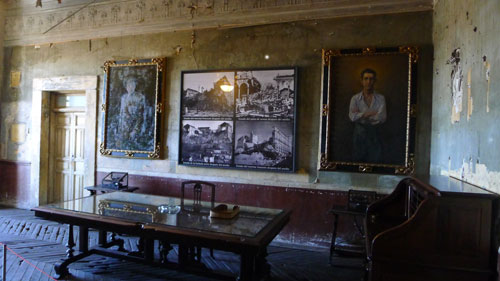
The telephone call and demand of the Reds that the Alcazar be surrendered in exchange for Luis's life is shown in the Genina film in a very moving and dramatic scene never to be forgotten.
Moscardo and his office were able to print a mimeographed newsletter 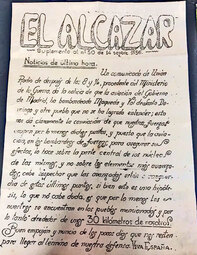 during the siege to keep up morale and to keep everyone informed of developments and challenges they faced inside the citadel. It was called El Alcazar and we show at right issue Nr. 50 dated 14 September 1936, two weeks before Franco's forces were able to arrive and rout the Reds and save the day. This newsletter is not in our Collection.
during the siege to keep up morale and to keep everyone informed of developments and challenges they faced inside the citadel. It was called El Alcazar and we show at right issue Nr. 50 dated 14 September 1936, two weeks before Franco's forces were able to arrive and rout the Reds and save the day. This newsletter is not in our Collection.
BELOW, a press photo from our Collection of the film director Augusto Genina adjusting the make-up of actor Rafael Calvo during the film-shoot. Calvo played the role of Colonel Moscardo.
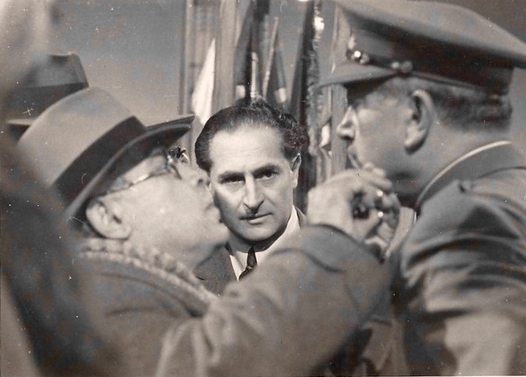
The siege of the Alcazar lasted seventy long days and nights. The holding out by Franco’s forces against such odds became a huge propaganda and morale–boosting victory of the nationalist forces, which in 1940, was told brilliantly in Genina's The Siege of the Alcazar.
The Alcazar after seventy days and night of Red bombardment:
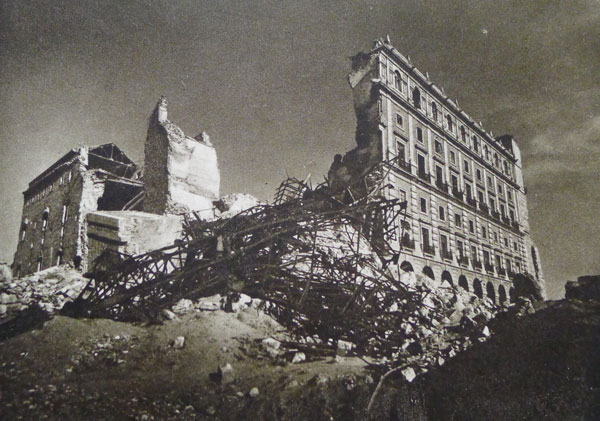
In early 1941, before the Italian film had been released, at Dr. Joseph Goebbels' request, Karl Ritter and his sometime co–scriptwriter Felix Lützkendorf devised a film script about the fate of the German Embassy in "Red Madrid." The film had the working title of "Der Botschaft" (The Embassy). When the Augusto Genina film about the siege of the Alcazar by the Reds was premiered at the 1941 Venice Film Festival, and won the Mussolini Cup for excellence, Goebbels had the film screened for Ritter and other film directors in Berlin and stated that it "could not be bettered." The idea of a German feature film about a similar theme was dropped. (Gillespie, KARL RITTER; 2nd ed; pg.140–141).
We have in our Collection three posters for the film, one from Belgium which uses the same graphic designs as one of the German film posters, a small (A4) original Spanish poster, and the DIFU (German–Italian Film Union) poster used to promote the German synchronised (dubbed) version shown in the Third Reich. We also own four original Italian Fotobusta large colour lobby cards for the film. Additionally, we own the 56 page Italian press-book for the film issued by Film Bassoli film studios in Rome, published in four languages, including English. We also own the DIFU German language cinema owner's guide (Werberatschlag) for the film; ten film stills from 1940/41, and six Film Bassoli photographs taken at the Spanish premiere of the film in Madrid on 28 October 1940.
Here is the Film Bassoli English language plot summary of this exciting feature film, reproduced from our 1940 press-book:
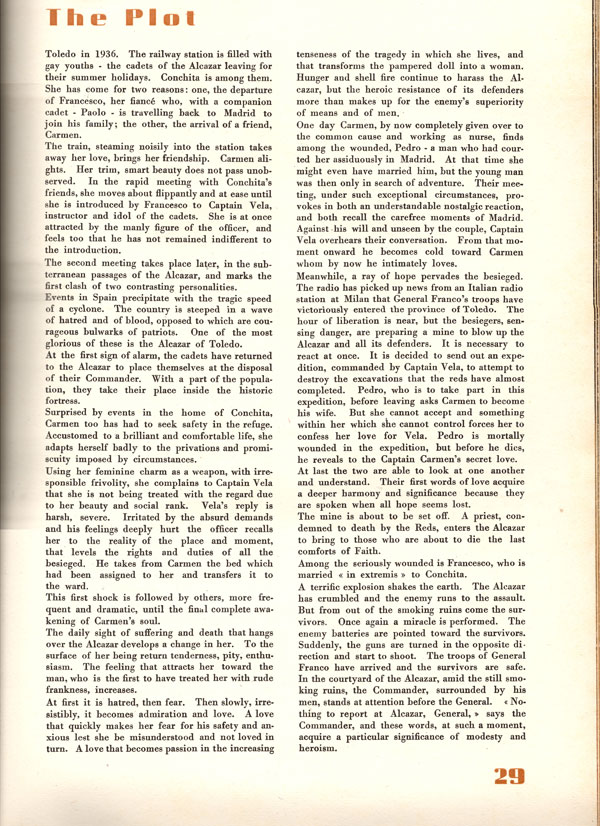
The Madrid premiere of the film in Franco Spain was a major event. Here are five photographs of the premiere. Note the huge replica of the Alcazar atop the cinema entrance, and the audience salute to the heroic defenders of the citadel against the Reds.


The Film Bassoli press–book not only has articles on the film plot, an introduction to the film by the director, and further articles on the historic and architectural authenticity of the sets built in Cinecittá, as well as background information on the cast; but also six beautiful full–colour plates . We reproduce two of them here:
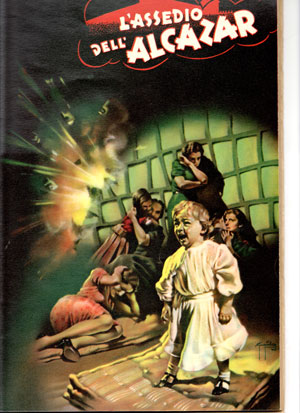
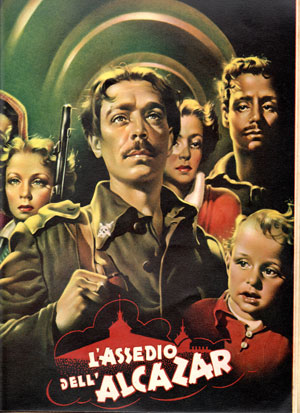
The film was dubbed into German and exported and released through DIFU in Third Reich cinemas, where it was a major success with extended cinema runs and much publicity. German audiences knew of the siege and Franco's victory, and of course of the role that the Legion Condor played in supporting Franco's victory across Spain. From our DIFU Collection:
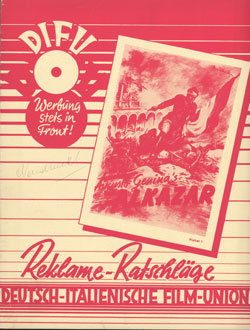
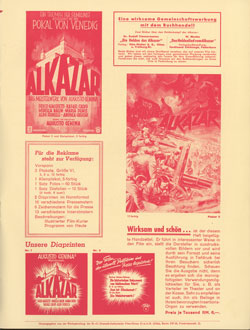

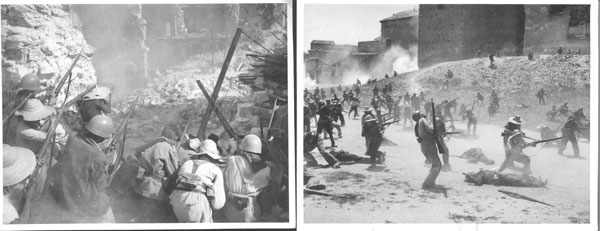


Don't forget to visit the poster page with original film posters from 1940/41 for this amazing film!

